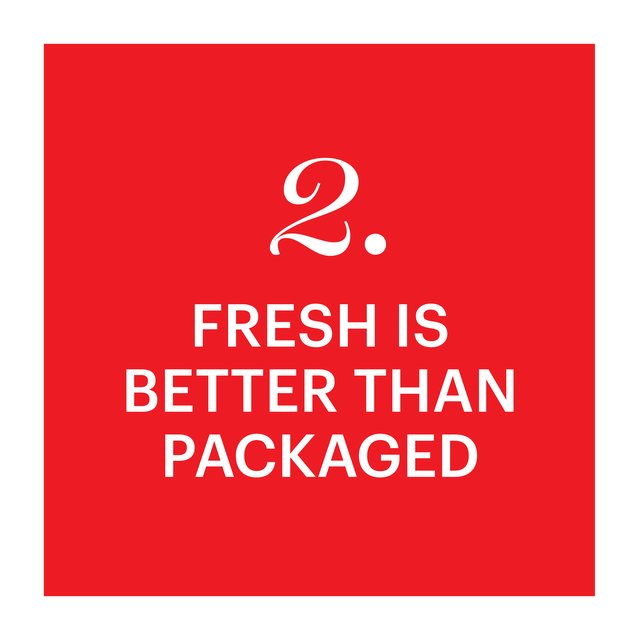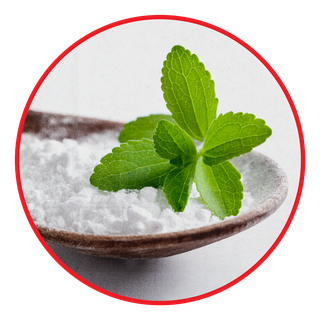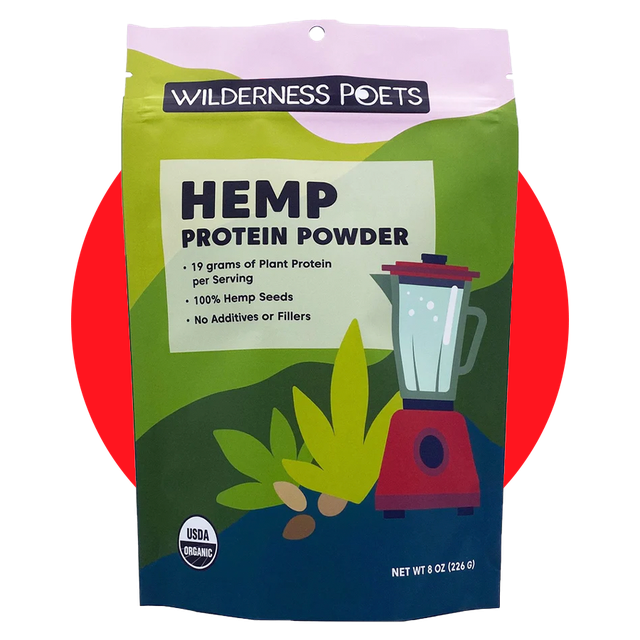JUMP TO: 5 Myths About Processed Food |5 Processed Ingredients That Aren’t Unhealthy | The Truth About No-Calorie Sweeteners | 3 Dietitian-Approved Protein Powders | Your Processed Food Feast
I COULD BLAME a lot of people for making my job as a dietitian more difficult. By the time my clients find me, Gwyneth Paltrow has filled their head with goop, Dr. Oz has convinced them gluten is hell spawn, and the Internet has … well, the Internet. (Also now see RFK Jr.)
But if I had to pick the guy who made eating healthfully especially challenging for me and my clients, I’d go with Michael Pollan, who notoriously summarized in his 2009 book, In Defense of Food: “Don’t eat anything your great grandmother wouldn’t recognize as food.” I get—and appreciate—that Pollan was trying to simplify nutrition. Healthy food is just that: food.
But after Pollan’s manifesto, a pileup ensued. The Food Babe (remember her?) started calling out any food that contained anything artificial. Panera started a PR campaign around its “no-no” list of banned ingredients. And some researchers even went as far to label certain foods as unprocessed, minimally processed, and ultra-processed, the latter of which they’ve linked to nearly every disease on the planet.
Yes, I do tell my clients to eat fewer ultra-processed foods and more minimally processed foods. That way you’re prioritizing nutrients like muscle-building protein, stomach-filling fiber, and heart-healthy good fats—nutrients largely absent in ultra-processed foods like candy and soda.
But processed fortified foods such as breakfast cereals, bread, milk, and even pasta can help consumers eat many of the micronutrients they lack while remaining inexpensive and accessible. It’s also worth mentioning that certain forms of processing keep us safe from botulism, salmonella, e.coli, and all sorts of other nasty foodborne illness.
In short—and with all due apologies to your great grandmother—eating a diet completely free from unrecognizable ingredients isn’t just impossible, it’s kind of bullshit.
So what are you supposed to do? What I also tell all my clients to do: Embrace all food as food. Then try to choose the best options available considering where you live, how much money you have to spend on food, and what you like. Prioritize produce, whole grains, protein, nuts, and legumes—regardless of if they’re fresh or packaged.
It’s simple, I know.
That’s exactly the point.

I hear these a lot as a dietitian. Here’s what I tell my clients.

If you grow it or raise it and harvest it yourself, sure. But really any food at the grocery store is processed in some way—pasteurizing, grinding, pre-cooking, or manipulating a food in any way qualifies as processing. Yes, it’s possible to live on just whole foods, but it’s not feasible for the vast majority of us.

Actually, packaged fruits and vegetables are picked at peak ripeness, then flash-processed. That means they grow on the plant longer, which increases their nutrient content. Fresh produce is often picked before its peak, to ripen on the truck.

I know, because that’s where the fresh stuff is. While it’s true that fresh foods should make up as much of our diets as possible, the inside aisles of the supermarket have a lot to offer: canned beans and lentils, nuts and seeds and nut butters, grains and pastas, canned fish. Sure, there are also the chips and cookies, which are fine as well. Nothing should be off-limits in a varied, healthy diet.

Did you know that a bowl of Cheerios with milk has 90 percent of your daily iron requirements?That’s because, through processing, food companies fortify some cereals (and breads, and eggs, and yogurt, and…) with additional nutrients. Fortified cereals are quick, easy, cheap, and a great source of fiber, protein, and vitamins. Enjoy them already!

There is no human or reliable animal research that suggests that genetically modified foods have negative health impacts. GMO food crops are limited in North America—soybeans, and corn, most of which are used to feed animals; sugar beets, canola, potatoes, papaya, some apples, and pink pineapples. Still, the “non-GMO” claim is used on foods that have never been grown as GMO crops. Beware.

Not true. White rice is a staple food for 3.5 billion people on the planet. Although brown rice is a whole grain, it’s only slightly more nutritious than its white counterpart at one more gram of fiber per cup. White rice is nutritious, contains protein, and is usually enriched with iron and B vitamins. It’s filling, inexpensive, and delicious.
QUIZ TIME!
WHICH HAS MORE NUTRIENTS?

A
A green juice smoothie, made with celery, apple, spinach, kale, parsley, and lemon

B
A bowl of Cheerios with milk
THE ANSWER IS…
B!
While the green juice contains more of some vitamins such as A, K, and folate, the cereal wallops it in every other category: fiber, protein, and overall vitamin content. The milk adds potassium and more vitamins.


These often-no-no’ed foods are staples worth having in your kitchen.

1.MSG
2.REGULAR OL’ SALT
Like iodized salt. Sea salt, while trendy and delicious, contains no iodine, which is a mineral essential in the prevention hypothyroidism, which can lead to gout.
3.PRODUCTS THAT CONTAIN CARRAGEENAN
A stabilizer and thickener, carrageenan has been vilified as a toxic and harmful ingredient by many a social media influencer. However, food-grade carrageenan, which is the type used in foods (sour cream, coconut milk), is perfectly safe. Degraded carrageenan—now called poligeenan—is not, but we don’t eat it anyhow; it’s used in medical procedures.
4.WHITE FLOUR
While whole wheat and other grain flours may be higher in fiber, white flour is safe to consume and nutritious.
5.CANOLA, CORN, OR ANY OTHER SEED OIL
The preponderance of research suggests that this supposedly “inflammatory” ingredient is actually anti-inflammatory. Yes, it’s processed, but so is every other edible oil. The processing of seed oils creates a product that’s shelf-stable, safe, and accessible.


Every few years a study emerges that links processed artificial sugar to a scary disease. In 2023, it was one published in Nature, which showed that erythritol, a sugar alcohol sweetener found in many low-carb packaged foods, increased risk of heart attack and stroke.
This study suffered from similar flaws as others that have come before (the research was observational instead of a dietary intervention, the study population was 65+ with pre-existing heart troubles), but the sensational headlines soon followed. If you look at the bulk of data, no-calorie sweeteners are totally safe to consume. (As is real sugar, in its many forms.) Here’s how it all breaks down.
ERYTHRITOL

WHAT IT IS: A sugar alcohol found in keto-friendly ice cream, cookies, and protein bars, but also in fruits, vegetables, wine, and beer.
WHER IT COMES FROM: The fermentation of glucose.
WHAT THE RESEARCH SAYS: While some studies have linked it to cardiovascular disease and toxicity, no solid research says it’s dangerous to humans. The FDA deems it “generally recognized as safe (GRAS).”
STEVIA

WHAT IT IS: A sweetener found in sodas, ice creams, candy, and gums, can also be bought for use in baking and beverages.
WHERE IT COMES FROM: The leaves of the stevia shrub.
WHAT RESEARCH SAYS: Stevia doesn’t impact blood glucose, and the FDA has given it a “GRAS” designation.
SUCRALOSE

WHAT IT IS: A synthetic sweetener, also known as Splenda, used in some candy, soda, and yogurt.
WHERE IT COMES FROM: Sucralose is made by replacing three hydroxyl groups on a sucrose molecules, with chlorine atoms. In other words, sucralose is made from white sugar, but has been manipulated to pass through the body undigested.
WHAT THE RESEARCH SAYS: Some animal studies suggest that a high intake of sucralose may affect immunity and the gut microbiome, human studies showing these effects are lacking. The FDA has classified sucralose as “GRAS.”
XYLITOL

WHAT IT IS: a sugar alcohol that’s found in plants. Humans also make xylitol through the metabolism of carbohydrate.
WHERE IT COMES FROMWhere it comes from: The fermentation of hemicellulose from plants.
WHAT THE RESEARCH SAYS: Xylitol can have side effects like gas, bloating, and diarrhea in some people, and for those who have IBS, but Xylitol is recognized by the FDA as safe.
MONKFRUIT

WHAT IT IS: a plant-based zero-calorie sweetener.
WHERE IT COMES FROM: by crushing the seeds and skins of monkfruit, a gourd-like fruit native to China.
WHAT THE RESEARCH SAYS: Monkfruit appears to be safe as a food additive, and has the GRAS designation from the FDA.

ABOUT REAL SUGAR…
DON’T BELIEVE PEOPLE who tell you that agave syrup is any better for you than maple syrup or even white sugar because of how it’s processed. Sugar is sugar—and your body processes it in the same way.
But what about the added minerals in so-called unprocessed sugars?, those people argue. The trace minerals in “natural sugars” are just that: trace. You’d have to eat an enormous quantity of these sweeteners to get any sort of meaningful amount of nutrients.
Also: please don’t get your nutrients from sugar.


By most definitions, your go-to muscle-building supplement is ultra-processed. That shouldn’t disqualify it from your diet, though. In fact, many non-diary protein powders aren’t just good for muscle synthesis, they contain a hefty amount of fiber and other nutrients too. We asked Ryan Andrews, R.D., assistant professor of nutrition at Regis College for his top picks.
Garden of Life Sport Organic Plant-Based Protein
The mix of protein sources (pea, navy bean, lentil, chickpea) offers a wide variety of recovery-enhancing amino acids. Two scoops have 160 calories and 30 grams of protein. And it’s Informed Choice Certified and NSF Certified for Sport, ensuring that it’s free of banned substances.
Vega Premium Sport Protein
The mix of plant proteins, tart cherry, and turmeric to potentially aid in recovery—all for 160 calories and 30 grams of protein in one scoop. It’s also NSF Certified for Sport.
Wilderness Poets Hemp Protein Powder
This is straight hemp protein. No sweeteners, thickeners, or extra ingredients. But the taste is mild and blends easily into a smoothie. If you’re having GI reactions to other powders, give this one a try. It has 19 grams of protein and 157 calories per serving.



This is pretty much the greatest pantry meal ever: it’s packed with fiber, protein, and antioxidants, and it takes less than 30 minutes to prepare.
WHAT YOU’LL NEED:
- 1 box dry bucatini
- 1 (15 oz) can chickpeas, drained and rinsed
- 1 (11 oz) package frozen broccoli
- 1 (24 oz) jar tomato sauce
HOW TO MAKE IT:
- In a large pot of boiling salted water, cooking the pasta according to package instructions.
- As the pasta boils, in medium pot, add the chickpeas, broccoli, and tomato sauce. Heat over medium-high, then lower the heat to a simmer.
- Drain the pasta and add it to the pot with the sauce. Stir well until combined. Serve. Feeds 4





